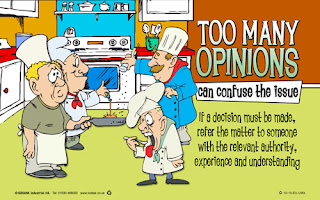 |
| 1 |
 |
| 2 |
 |
| 3 |
I read a quote yesterday that said anything that improves a process does so by simplifying it. This is true of so many processes – especially communication.
Poor communication can cause many failings in a workplace – confusion, inaccuracy and catastrophe are just some of them. Over time these can fester into frustration, conflict and resentment between your employees.
So how do we simplify our communications and make them more effective?
Make it C.L.E.A.R.Ensure the information you are imparting is:
Complete, as far as possible;
Located in the correct and logical place;
Explained as fully and clearly as you can;
Accurate with all the relevant information; and
Readable if hand-written
Located in the correct and logical place;
Explained as fully and clearly as you can;
Accurate with all the relevant information; and
Readable if hand-written
Choose the correct recipients
How many times, as a customer, have you telephoned a business and been passed through to three or more people before you finally get to speak to the right person?
How many times, as a customer, have you telephoned a business and been passed through to three or more people before you finally get to speak to the right person?
Reaching the right recipients is sometimes as simple as putting the information in the right place, so that everyone who needs access, has access.
If the information pertains to an issue that needs resolving, then it may be more about listening carefully and gaining a sufficient understanding of the problem to determine who is best-equipped to deal with it.
Choose the correct method of communication
Try to ensure that the method of communication is as clear, concise and efficient as possible.
Try to ensure that the method of communication is as clear, concise and efficient as possible.
For example, if a message is so complicated that it would take an essay to explain it properly in writing, then it may be best to talk to the person directly.
Similarly, email is not the best medium if you require an immediate answer or if your issue is likely to need resolving via a two-way conversation.
Communicate as directly as possible
If you ever played Whispers as a child, you will know how a message can change the more people it passes through. The same is true in a workplace – the more people who pass on a message, and put their spin on it, the less likely it will reach the recipient(s) as it was intended.
If you ever played Whispers as a child, you will know how a message can change the more people it passes through. The same is true in a workplace – the more people who pass on a message, and put their spin on it, the less likely it will reach the recipient(s) as it was intended.
Within reason, try to encourage a more open system where people can communicate more directly between each other and between departments. The shorter the chain of people involved, the more likely it will be delivered in a timely manner and with less capacity for misunderstandings.
The same is true when making day-to-day decisions. The more people involved and the more opinions on the table, the harder it is to reach a conclusion. Involving only those with the relevant experience and authority makes the process simpler and easier to administer.
Communicate as consistently as possible
As a customer, have you ever been liaising with a company where several different people have given you several conflicting pieces of information? Frustrating, isn't it?
As a customer, have you ever been liaising with a company where several different people have given you several conflicting pieces of information? Frustrating, isn't it?
Problems like this are usually down to data quality – or lack of it. To communicate effectively and consistently, both inside and outside the company, everyone needs access to the same current information, which should, ideally, be updated across the board.
Kodiak's motivational workplace poster programme deals with simple and effective workplace communications on a regular basis.
If you would like to find out more about how our posters can help to improve communications in your workplace, please contact us for an informal chat.

No comments:
Post a Comment